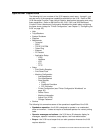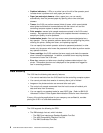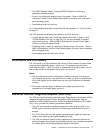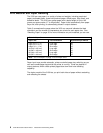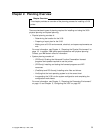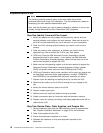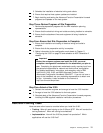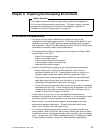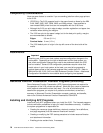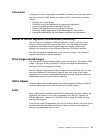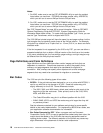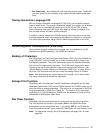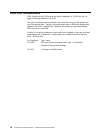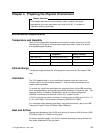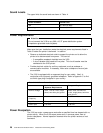
Chapter 3. Preparing the Processing Environment
Chapter Overview
This chapter contains information to help system programmers integrate the
3130 into the existing processing environment. The basic hardware, software,
and application requirements for the 3130 are described in Appendix B,
“Software and Hardware Requirements” on page 59.
Performance Considerations
The quality of 3130 output is affected by the paper you use and the
composition of the logical pages you print. To ensure printing legibility in your
application, test small (4-point) fonts and special characters such as logos in
your application. Refer to the
IBM Advanced Function Printer Cut-Sheet Paper
Reference
for information about these considerations.
The following factors affect the performance of the system and directly affect
communication to the 3130:
– Speed of the computer system
– Amount of available memory
– Priority of tasks assigned in the system
– Control program used to drive the printer
– Attachment type and line speed.
Consider the following when setting up your host-attachment configuration:
– Before attaching the 3130 to non-IBM equipment, ensure that the
equipment supports the 3130. The equipment vendor can answer your
questions about configuration options and other attachment issues.
– High-speed, direct-access storage devices (DASD) are recommended for
spool data sets and library data sets, particularly for printing workloads
consisting of documents with many fonts and images.
– Printer performance is best when high-use devices are used on a separate
attachment from the 3130. Printer throughput can be degraded if the 3130
is attached with other high-use devices such as disk units, tape units, or
another 3130 that prints complex documents.
Printer traces, which you can run to help diagnose problems with the
attachment, the software, or the printer microcode, run in the background while
the printer performs its normal operations, and may reduce throughput.
When memory can hold fonts and images for several pages at one time,
performance improves substantially. Complex documents require more
memory and, therefore, can take longer to print.
To minimize the downloading of fonts, consider using printer resident fonts
when possible. When using IPDS, also consider marking host fonts as "public"
to allow the printer to capture and internally cache frequently used non-resident
fonts. You can order up to 32MB of additional memory in increments of 16MB.
To order additional memory, contact your IBM marketing representative.
Copyright IBM Corp. 1994, 1996 13



